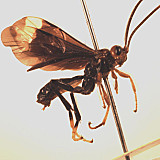Physotarsus varicornis Cameron, 1886
Scolobates variicornis: Dalla Torre 1902: 328 (catalog, unjustified emendation).
Physotarsus varicornis: Townes in Townes & Townes 1966: 139 (new combination); Yu and Horstmann 1997: 455 (catalog); Zhaurova and Wharton 2009: 30 (list of valid species of Physotarsus); Zhaurova and Wharton 2009: 9-10, 49-51 (synonymy, redescription, lectotype designation, inclusion in key to species).
Physotarsus davidi Gauld, 1997: 197-198. Holotype female in INBio.
Physotarsus davidi: Yu and Horstmann 1997: 455 (catalog); Zhaurova and Wharton 2009a: 28 (list of valid species of Physotarsus); Zhaurova and Wharton 2009b: 49 (synonymized under varicornis).
This species is most similar to P. maculipennis (Cameron), with which it shares the smooth body, pectinate claws, and dark wing with pale subapical band. Physotarsus varicornis is a distinctly darker species.
There are no specimens currently determined for this OTU, or those specimens determined for this OTU are not yet mappable.
This material is based upon work supported by the National Science Foundation under Grant Number DEB 0328922 with REU supplement DEB 0723663.
Any opinions, findings, and conclusions or recommendations expressed in this material are those of the author(s) and do not necessarily reflect the views of the National Science Foundation.



